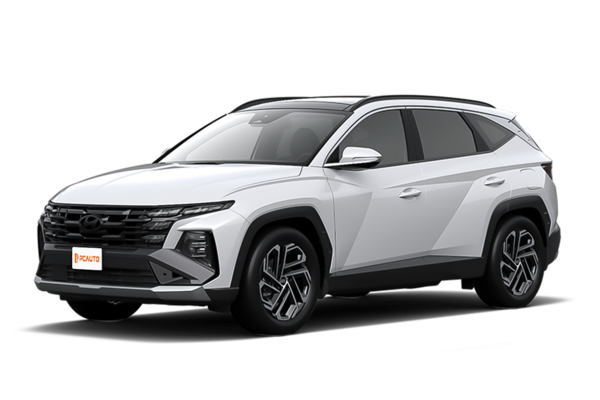Q
Will the 2025 Tucson have a larger touchscreen?
Based on current information, the 2025 Tucson is expected to upgrade its interior tech features, likely including a larger touchscreen to keep pace with the industry trend favoring big displays and smart connectivity. Exact screen dimensions and functionality details will require official confirmation.
Hyundai has been steadily refining its infotainment systems—the current Tucson already offers a 10.25-inch touchscreen with wireless CarPlay, so the new model may further enhance display quality or integrate more localized apps. Beyond the screen, potential upgrades could include improved voice control or advanced driver-assistance features, which often accompany such tech refreshes.
If in-car connectivity is a priority, keep an eye on official updates while cross-checking specs against rivals like the CR-V or RAV4. This kind of comparison helps gauge how the new Tucson stacks up in practicality.
Special Disclaimer: This content is published by users and does not represent the views or position of PCauto.
Related Q&A
Q
How much is insurance on a 2025 Hyundai Tucson?
**Insurance Costs for the 2025 Hyundai Tucson**
The insurance premium for the 2025 Hyundai Tucson varies depending on the specific model, engine capacity, type of coverage, and driver profile (age, driving record, etc.). On average, comprehensive insurance for a new Tucson may range between RM2,500 to RM5,000 per year, but it’s best to get a personalized quote from insurers.
Factors affecting premiums include the car’s market value, safety features, anti-theft systems, and the insurer’s risk assessment policies—for example, models with Advanced Driver Assistance Systems (ADAS) may qualify for discounts. You can also lower costs by opting for a higher excess or leveraging your No-Claim Discount (NCD).
Before buying, compare policies across insurers and check the fine print—like coverage for natural disasters or third-party liability—to find the right protection for your needs.
Q
Are all 2025 Hyundai Tucson AWD?
**2025 Hyundai Tucson AWD Availability**
Not all trims come standard with AWD—it depends on the version and powertrain. Base models typically stick with front-wheel drive (FWD) for better fuel economy and lower pricing, while higher trims or sport-oriented variants may offer AWD as an option or standard equipment, especially with turbocharged engines.
Hyundai’s AWD system improves traction on wet roads or winding routes, making it a smart pick for rainy climates or frequent mountain driving. Just note: it adds a slight hit to fuel efficiency and upfront cost. If you need four-wheel drive, check your local dealer’s specs or look for the "HTRAC" badge (Hyundai’s smart AWD system).
Competitors like the Honda CR-V or Toyota RAV4 follow a similar strategy, reserving AWD for select trims. Where the Tucson stands out? Its hybrid powertrain can pair with AWD—a rare combo that balances efficiency and all-weather capability. Cross-shop accordingly.
Q
How much is a Hyundai Tucson 2025 resale value?
As an automotive editor discussing the projected resale value of the 2025 Hyundai Tucson, there’s no official data yet since the model hasn’t hit the market. Resale values are typically assessed post-launch based on factors like market performance, trim options, ownership volume, and maintenance costs.
For now, we can look to the current Tucson’s depreciation trends as a reference. Generally, a three-year-old Tucson retains about 60-70% of its value, while a five-year-old model holds around 50-60%—though this varies with condition, mileage, and service history.
Key factors influencing resale value include:
- **Powertrain reliability** (e.g., differences between the 1.6T turbo and hybrid variants)
- **Tech features** (e.g., how widely ADAS systems are adopted)
- **Market competition** (e.g., demand for rivals like the Honda CR-V or Toyota RAV4)
To maximize future resale, opt for popular configurations and keep meticulous maintenance records. If resale value is a priority, check local used-car platforms or dealer listings for historical transaction data on similar models.
Q
When did 2025 Tucson come out?
The 2025 Hyundai Tucson has begun its global rollout in Q1 2024, with local market availability expected by mid-to-late 2024. As the latest iteration of Hyundai's best-selling SUV lineup, this model retains the brand's signature design language while sporting more futuristic upgrades to the front grille, lighting clusters, and body contours.
Inside, you'll find a dual-screen setup and a smarter infotainment system. Powertrain options will likely include a 2.0L naturally aspirated engine, a 1.6T turbocharged unit, and a hybrid variant. Notably, the new Tucson gets significant upgrades in active safety tech, featuring enhanced smart cruise control and automated parking assist.
For those in the market for a new ride, keep an eye out for dealer test-drive events to experience its improved cabin space and driving dynamics firsthand. It’s also worth cross-shopping rival models in the segment to compare specs and pricing before making a decision.
Q
How much will the 2025 Hyundai Tucson cost?
The anticipated price range for the 2025 Hyundai Tucson is expected to be between RM120k to RM160k, depending on trim levels and powertrain options. The base 2.0L naturally aspirated variant will likely sit at the lower end, while the 1.6T turbo hybrid or top-spec N Line could push toward the higher bracket.
This SUV retains the brand’s signature parametric diamond grille and may feature upgraded next-gen driver-assist tech, like remote parking or highway lane-change automation. Competing against rivals such as the Honda CR-V or Toyota RAV4 (typically priced around RM130k–RM180k), the Tucson stands out with perks like a longer factory warranty (usually 5 years/unlimited mileage) and standard ventilated seats.
Notably, Hyundai’s recent hybrid advancements could give the Tucson Hybrid a combined fuel economy as low as 5L/100km—a big plus for city drivers facing heavy traffic. If you’re interested, keep an eye out for the official Q3 launch for confirmed specs and potential promotions, like free service packages or low-interest financing.
Q
What is the range of the 2025 Tucson?
The all-electric 2025 Tucson is expected to deliver around 450 km of range (WLTP), though official figures may vary. This should cover daily commutes and short trips with ease, plus it supports fast charging—just 30 minutes to 80%. Opt for the hybrid version, and you’re looking at 800+ km on a full tank, striking a balance between fuel efficiency and long-distance practicality.
Keep in mind, real-world range depends heavily on driving style, terrain, and weather. Pro tip: use regen braking and select the right drive mode to maximize efficiency. Competitors like the CR-V Hybrid or RAV4 Prime offer 500-900 km, but the Tucson pulls ahead with smarter tech—think standard lane-keeping assist and adaptive cruise.
Charging infrastructure? DC fast chargers are now widespread in major Chinese cities, and a home wallbox makes overnight top-ups a breeze. Before deciding, test-drive both powertrains and check the official energy consumption data for a full picture.
Q
What engine goes in the 2025 Hyundai Tucson?
The 2025 Hyundai Tucson is expected to carry over its current powertrain lineup, offering multiple engine options to suit different needs. Buyers can choose between the 2.0L MPI naturally aspirated gasoline engine (156 hp/192 Nm), the peppy 1.6L T-GDi turbocharged gasoline unit (180 hp/265 Nm), or the 1.6L turbo hybrid system delivering a combined 230 hp. Diesel lovers in select markets might also get the 2.0L diesel option (186 hp/416 Nm), though final specs are subject to official confirmation.
Hyundai has struck a nice balance between fuel efficiency and performance in the Tucson's powertrains, with the hybrid variant being the go-to for eco-conscious drivers who want to save at the pump. As one of the brand's best-selling SUVs, the Tucson benefits from Hyundai's Smartstream engine technology, which optimizes combustion efficiency and thermal management. It pairs with either a 7-speed dual-clutch or a 6-speed automatic transmission for smooth, predictable driving dynamics.
If you're after more spirited performance, the 1.6T is the sweet spot, while the hybrid makes the most sense for daily commutes. Hyundai's recent innovations, like the CVVD (Continuously Variable Valve Duration) tech, further enhance engine efficiency—definitely worth keeping an eye on.
Q
What generation is the 2025 Tucson?
The 2025 Tucson is a mid-cycle refresh of the fourth-generation model, which originally debuted in 2020 with the chassis code NX4. This update primarily focuses on exterior styling and tech upgrades.
The new Tucson features sharper Parametric Dynamic design elements, with a more distinctive front grille and LED daytime running lights. Inside, it keeps the dual 10.25-inch screen setup but gets the latest infotainment system, including wireless Apple CarPlay and Android Auto.
Powertrain options will likely carry over, including the 1.6L turbo gasoline and 2.0L diesel engines, with hybrid variants possibly available in select markets. As with most mid-cycle updates, expect refinements in driver-assist tech—things like smart cruise control and lane-keeping should be more precise.
The Tucson has always stood out in its class for bold design and tech features, plus it offers solid practicality for families. If you want the full details, your best bet is to check it out in person at a local dealer or schedule a test drive to feel the updates for yourself.
Q
Is the 2025 Hyundai Tucson bigger than the 2024?
Judging from the officially released specs, the 2025 Hyundai Tucson remains virtually unchanged in dimensions compared to the 2024 model, with no significant alterations to its wheelbase, length, or width. The upgrades primarily focus on tech features and styling refinements—think a likely refreshed front fascia and more advanced infotainment system.
As a popular SUV, the Tucson has always delivered decent space efficiency. Its rear legroom and cargo capacity rank above average in its class, making it a solid choice for families. If you need even more space, there's the seven-seat Tucson XL, though that model does come with a noticeably larger footprint.
These days, many automakers are prioritizing functional upgrades over simply making vehicles bigger. It's a smart move—keeping the model versatile while staying competitive through tech enhancements. The Tucson's refresh clearly follows that trend.
Q
What transmission does 2025 Tucson have?
The 2025 Tucson models come with different transmissions. The 2025 Hyundai Tucson Style G2.0 MPi is equipped with a 6-speed AT (Automatic Transmission), which features mature technology and good shift smoothness, meeting the comfort needs of daily driving. The 2025 Hyundai Tucson Prime 1.6T-GDi and 2025 Hyundai Tucson Prestige 1.6T-GDi AWD are fitted with a 7-speed DCT (Dual-Clutch Transmission). The dual-clutch transmission offers fast shift speed and high transmission efficiency, with more direct power delivery, bringing drivers better driving pleasure and power response. The 2025 Hyundai Tucson Prestige 1.6T-GDi Hybrid is equipped with a 6-speed AT. When paired with the hybrid system, it enables more linear and stable power output, helping to enhance the vehicle's ride comfort and fuel economy.
Latest Q&A
Q
How much is insurance on a 2025 Hyundai Tucson?
**Insurance Costs for the 2025 Hyundai Tucson**
The insurance premium for the 2025 Hyundai Tucson varies depending on the specific model, engine capacity, type of coverage, and driver profile (age, driving record, etc.). On average, comprehensive insurance for a new Tucson may range between RM2,500 to RM5,000 per year, but it’s best to get a personalized quote from insurers.
Factors affecting premiums include the car’s market value, safety features, anti-theft systems, and the insurer’s risk assessment policies—for example, models with Advanced Driver Assistance Systems (ADAS) may qualify for discounts. You can also lower costs by opting for a higher excess or leveraging your No-Claim Discount (NCD).
Before buying, compare policies across insurers and check the fine print—like coverage for natural disasters or third-party liability—to find the right protection for your needs.
Q
Are all 2025 Hyundai Tucson AWD?
**2025 Hyundai Tucson AWD Availability**
Not all trims come standard with AWD—it depends on the version and powertrain. Base models typically stick with front-wheel drive (FWD) for better fuel economy and lower pricing, while higher trims or sport-oriented variants may offer AWD as an option or standard equipment, especially with turbocharged engines.
Hyundai’s AWD system improves traction on wet roads or winding routes, making it a smart pick for rainy climates or frequent mountain driving. Just note: it adds a slight hit to fuel efficiency and upfront cost. If you need four-wheel drive, check your local dealer’s specs or look for the "HTRAC" badge (Hyundai’s smart AWD system).
Competitors like the Honda CR-V or Toyota RAV4 follow a similar strategy, reserving AWD for select trims. Where the Tucson stands out? Its hybrid powertrain can pair with AWD—a rare combo that balances efficiency and all-weather capability. Cross-shop accordingly.
Q
How much is a Hyundai Tucson 2025 resale value?
As an automotive editor discussing the projected resale value of the 2025 Hyundai Tucson, there’s no official data yet since the model hasn’t hit the market. Resale values are typically assessed post-launch based on factors like market performance, trim options, ownership volume, and maintenance costs.
For now, we can look to the current Tucson’s depreciation trends as a reference. Generally, a three-year-old Tucson retains about 60-70% of its value, while a five-year-old model holds around 50-60%—though this varies with condition, mileage, and service history.
Key factors influencing resale value include:
- **Powertrain reliability** (e.g., differences between the 1.6T turbo and hybrid variants)
- **Tech features** (e.g., how widely ADAS systems are adopted)
- **Market competition** (e.g., demand for rivals like the Honda CR-V or Toyota RAV4)
To maximize future resale, opt for popular configurations and keep meticulous maintenance records. If resale value is a priority, check local used-car platforms or dealer listings for historical transaction data on similar models.
Q
When did 2025 Tucson come out?
The 2025 Hyundai Tucson has begun its global rollout in Q1 2024, with local market availability expected by mid-to-late 2024. As the latest iteration of Hyundai's best-selling SUV lineup, this model retains the brand's signature design language while sporting more futuristic upgrades to the front grille, lighting clusters, and body contours.
Inside, you'll find a dual-screen setup and a smarter infotainment system. Powertrain options will likely include a 2.0L naturally aspirated engine, a 1.6T turbocharged unit, and a hybrid variant. Notably, the new Tucson gets significant upgrades in active safety tech, featuring enhanced smart cruise control and automated parking assist.
For those in the market for a new ride, keep an eye out for dealer test-drive events to experience its improved cabin space and driving dynamics firsthand. It’s also worth cross-shopping rival models in the segment to compare specs and pricing before making a decision.
Q
How much will the 2025 Hyundai Tucson cost?
The anticipated price range for the 2025 Hyundai Tucson is expected to be between RM120k to RM160k, depending on trim levels and powertrain options. The base 2.0L naturally aspirated variant will likely sit at the lower end, while the 1.6T turbo hybrid or top-spec N Line could push toward the higher bracket.
This SUV retains the brand’s signature parametric diamond grille and may feature upgraded next-gen driver-assist tech, like remote parking or highway lane-change automation. Competing against rivals such as the Honda CR-V or Toyota RAV4 (typically priced around RM130k–RM180k), the Tucson stands out with perks like a longer factory warranty (usually 5 years/unlimited mileage) and standard ventilated seats.
Notably, Hyundai’s recent hybrid advancements could give the Tucson Hybrid a combined fuel economy as low as 5L/100km—a big plus for city drivers facing heavy traffic. If you’re interested, keep an eye out for the official Q3 launch for confirmed specs and potential promotions, like free service packages or low-interest financing.
View MoreRelated News

Hyundai's Big Return to Malaysia: Top 5 Models Expected
MichaelMay 30, 2025

In Malaysia, which sliding door MPVs are available?
MichaelOct 30, 2025

Modern Ioniq 5 N Lands in Malaysia: Track-Level Performance Electric Vehicle is Here, Priced Possibly Below RM 400,000?
JohnSep 10, 2025

580,000 km & 87.7% Battery Health: Ioniq 5’s Incredible Durability
MichaelMay 6, 2025

Revolutionizing Hybrids: Hyundai’s New System vs. Toyota's Hybrid System
Kevin WongApr 22, 2025
View More













Pros
Cons